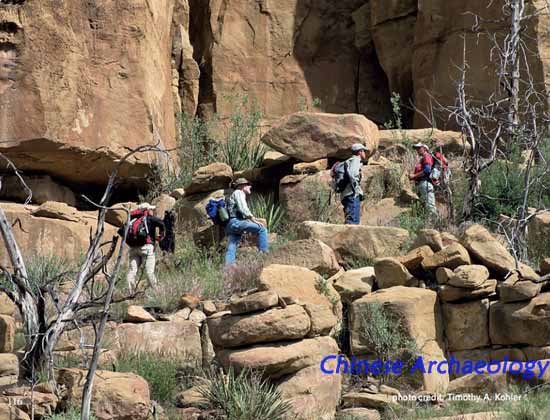The Village Ecodynamics Project: Pueblo Societies through Time in the US Southwest
The VEP studies ancestral Pueblo societies in southwestern Colorado and northern New Mexico. These were some of the most densely occupied portions of the US Southwest during the millennium from AD 600-1600 on which we focus. Archaeology in this area enjoys many advantages: abundant tree-ring dates; high site visibility and good preservation; a long history of both survey and excavation; and living descendants of the people we are studying, who are increasingly important partners in our research.
During this millennium there is much to explain. The societies in our area move from very small-scale habitations of one or a few households to towns containing several thousand people. Large areas in the north, including our study area in Southwest Colorado, were completely depopulated by the late-AD 1200s. Political organization and ceremonial practice apparently change radically during this period. All of these changes take place in conjunction with a great deal of climatic variability affecting amounts of maize production, the chief subsistence item in these societies, as well as variability in population size, growth rates, and degree of violence.
Our aim is to explain as many of these changes as we can use a combination of empirical research and agent-based computer modeling. We have developed innovative ways of assigning household counts to sites within very specific periods. This allows us to reconstruct paleodemographic profiles through time, and it also provides a database for assessing the performance of our simulations.

The simulations allow us to posit processes and observe how those processes play out through time and across space. Our base model is one in which households approximately optimize their locations so as to produce enough maize, gather enough wood and water, and hunt enough animals to sustain themselves in a landscape that is changing both through changing temperature and precipitation, and human use of resources. We layer complexity onto this base model according to the particular processes we wish to study. To date within this framework we have examined processes such as:
• the extent to which slowly regenerating resources (especially fuel-wood and deer) were depressed over centuries of use by Pueblo societies, and whether this might have contributed to various changes such as intensification of turkey husbandry, the only major food animal domesticated in prehispanic North America;
• how various exchange practices affected settlement patterns and the overall size of the population;
• which factors lead to the emergence of more complex (larger, more socially differentiated and politically stratified) societies in this area; and
• the relative importance of various factors that might have led Pueblo societies to vacate vast portions of the northern US Southwest in the thirteenth century AD.

Here I will summarize our key results to date, emphasizing the problem of aggregation (formation of villages) and also discussing how we can build approximate measures of the degree to which households locate themselves optimally with respect to the four resource categories we model. In these societies initial village formation is associated with increased population density and increased warfare. Households are located increasingly optimally with respect to resources for the first three hundred years of the occupation; later in time we suspect that groups, not households, were the social unit at which optimality must be assessed (which we have not yet accomplished). We introduce the concept of evolutionary public goods games as a way of understanding the co-evolution of group size and political complexity.
This research is significant because it is conducted on one of the best-understood Neolithic sequences in the world, and because it introduces computer simulation modeling as an important tool in archaeological research.
Timothy A. Kohler (Washington State University)
Biographical Sketch
Timothy (Tim) Kohler is an archaeologist employed in the Department of Anthropology at Washington State University, Pullman, who works primarily in the US Southwest. He was awarded an MA and PhD in Anthropology from the University of Florida, Gainesville. His main interests include modeling agricultural production and reconstructing demographic and settlement processes in ancient societies. This includes research oriented towards understanding how political hierarchies emerged in Neolithic societies. He has recently co-edited volumes entitled Leaving Mesa Verde: Peril and Change in the Thirteenth-Century Southwest (Tucson: University of Arizona Press, 2010) and Emergence and Collapse of Early Villages: Models of Central Mesa Verde Archaeology (Berkeley: University of California Press, 2012). He is a member of the External Faculty and Science Board of the Santa Fe Institute, New Mexico, and a Research Associate at Crow Canyon Archaeological Center, Colorado. For the past decade he has directed the Village Ecodynamics Project, an interdisciplinary, multi-institution attempt to understand settlement dynamics in the prehispanic Pueblo societies of the northern US Southwest.

